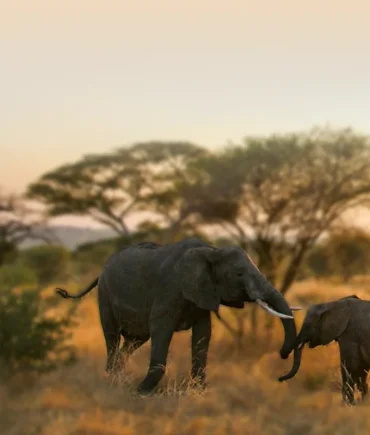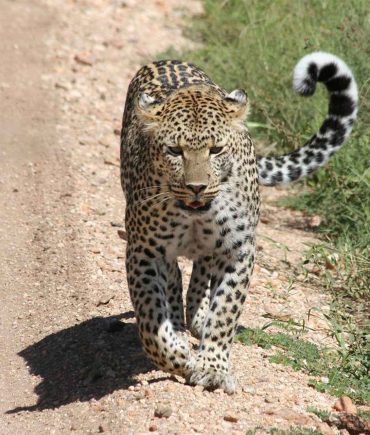The Great Wildebeest Migration
Witness the breathtaking spectacle of the Great Migration, where over a million wildebeest, zebras, and other animals journey across the vast Serengeti-Mara ecosystem. As they move in search of fresh grazing and water, you’ll experience the heart-pounding drama of predator-prey encounters, while new life emerges, continuing the circle of life.
This remarkable event, featuring around 1.5 million wildebeest alongside countless other herbivores, is a response to shifting weather patterns and the quest for nutrient-rich grasslands. Join us for an unforgettable adventure, where you’ll be front and center for one of nature’s greatest migrations.
Why do wildebeest migrate?
The wildebeest migration is a remarkable and critical survival strategy motivated by a desire for water and new grazing areas. This annual migration, which takes place mostly in the Serengeti habitat, is influenced by seasonal rainfall patterns that affect grass growth. As the dry season continues and available grass dwindles, wildebeests migrate to places where recent rains have created lush vegetation, assuring a steady supply of food and water.
For the wildebeests to survive, their yearly migration is crucial because it guarantees them access to vital supplies. Their movement coincides with the various phases of their calving and reproductive cycles, giving them the nutrition they need during these crucial times. In addition, this migration pattern facilitates the recovery and regeneration of the ecosystems they pass through, preserving environmental balance by preventing overgrazing and overcrowding in any one area.
When to go
The best time to experience the Wildebeest Migration in Africa depends on which part of the journey you want to catch. From June to October, you’ll witness the thrilling river crossings as wildebeests and zebras brave the Mara River, heading into Kenya’s Masai Mara. This period is full of action, with predators on the hunt, making it a favorite for safari enthusiasts.
For a quieter, more intimate experience, visit between November and March when the herds are in the southern Serengeti. It’s calving season, and the green plains are dotted with thousands of newborns, offering a peaceful safari away from the crowds. April to May, during the rainy season, the herds begin their southern journey again. While the rains bring lush scenery and fewer visitors, it can get muddy—adding a unique charm to this slower, quieter phase of the migration.
Explore tours
Safari Sample Tours
Verified My friend and I had an amazing vacation and made many memories that will last a lifetime. Our September 29th day trip to Mandara Hut along the Marangu Route was fantastic! My friend and I had an amazing vacation and made many memories that will last a lifetime. Our amazing guide, Daniel, made the walk both entertaining and instructive with his knowledge of Kilimanjaro and his enthusiasm for the mountain. The feeling of achievement at Mandara Hut, the breathtaking vistas, and the thick rainforest were all ideal. The owner, Daniel, made sure we were comfortable and educated at every turn, going above and beyond to make our stay unforgettable. Hilltop Travel and hiring Daniel as your guide are both excellent choices if you're thinking about visiting Kilimanjaro.Verified Any picture of kilimanjaro summit, Thank you to Hilltop Travel for making my recent day trip to Mount Kilimanjaro via the Marangu Route so unforgettable. Every step of the process was smooth and well-planned. An authority on the local landscape and customs, our guide ensured our comfort and kept us informed at every turn. The actual trek was magnificent, with beautiful views of the surrounding forests and towering hills. There were lots of opportunities for us to enjoy the breathtaking view, and the pace was ideal. Our guide provided fascinating information on the history of the mountain, the Chaga people's culture, and the local flora and fauna.Regardless of your level of competence, Hilltop Travel guarantees a safe, instructive, and genuinely remarkable Kilimanjaro experience. Highly recommended.Verified 7-day Machame trek with Hilltop Travel, Climbing Mount Kilimanjaro was an unforgettable adventure! I completed the 7-day Machame trek with Hilltop Travel, and I can’t recommend them enough. The entire journey, starting on July 23, 2024, was well-organized and expertly guided. From the very first step on the trail to the triumphant summit, the Hilltop Travel team provided exceptional support. A huge shoutout to our guide, Denis, whose unique approach truly made the journey special. His deep knowledge of the mountain, combined with his experience and calming presence, helped us navigate through the toughest parts of the trek. Denis not only guided us but also shared fascinating insights into the surrounding environment and local culture, which added so much to the experience. The support from Hilltop Travel team was also remarkable from the very start. Upon arrival at Kilimanjaro International Airport, the driver was waiting to pick us up, and we felt welcomed and well taken care of right from the start. Additionally, Daniel, the managing director, was incredibly helpful and attentive, ensuring everything went smoothly from the office side and checking in to make sure we had everything we needed. Their professionalism, knowledge, and attention to detail made the tough trek feel safe and enjoyable. The stunning landscapes and reaching the top were beyond words. If you're planning to conquer Kilimanjaro, climb with Hilltop Travel for an amazing experience.Verified My safari was Glorious My Mountain safari has been the best memory i made with my Girlfriend. We thought climbing a mountain was a very hard task but every step towards the roof of Africa was amaizing and with the help of wonderful guides from HillTop Travels just made things more easier. I look forward to booking my Safari with them because they made my experience worth it.Verified Good and frendly customer serviced The tour guides were exceptionally friendly and knowledgeable, providing fascinating insights that enriched my understanding and appreciation of the places we visited especially mount kilimanjaro. I felt well taken care of throughout the entire journey, and allowed me to truly relax and enjoy every moment.Verified kilimanjaro I recently climbed Kilimanjaro with Daniel as our mountain guide, and I couldn’t have asked for a better experience. Daniel is incredibly kind, intelligent, and very polite, with a great sense of humor that kept our spirits high throughout the journey. His expertise and leadership made me feel completely safe, and it was a true pleasure getting to know him and sharing this unique adventure. Highly recommended!

















